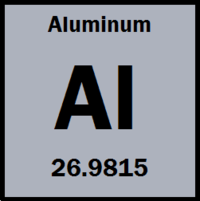Aluminum
Aluminum (Al) also called aluminium is the 13th element on the periodic table, and is the most abundant metal on Earth, making up 8.1% of the Earth's crust.[2] It is not found freely in nature, meaning that it is always found combined to other elements due to it being very reactive.[3] Aluminum is often found combined with oxygen. This is called aluminum oxide, the natural resource that's mined for aluminum oxide is a mineral called bauxite.[1] Aluminum was first extracted in 1825 by Hans Oersted, but it wasn't until the late 1880s when it became economically feasible to do so.
Some properties of aluminum include:[2]
| Atomic weight | 26.981538 |
| Density (at 0oC) | 2.7 g/cm3 |
| Boiling point | 2792 K |
| Melting point | 933.473 K |
| Electrical conductivity | 3.5×107 σ |
Energy of extraction
The extraction of aluminum is extremely energy intensive; it requires 190-230 megajoules of primary energy per kilogram of aluminum extracted and processed.[4] This is known as aluminum's embodied energy. In 2014, 49.3 billion kg of aluminum was produced[5] -- using the embodied energy of aluminum, this means that 9,367 PJ (9,367x1015 joules) of energy was required for its extraction and processing. The worldwide primary energy consumption in 2014 was 532,980 PJ,[6] meaning that 1.8% of the world's total primary energy supply went towards the production of aluminum.
Aluminum production also has a considerable CO2 footprint, at 8.24 kg of CO2 per kg of aluminum extracted.
This intense energy use is why it is important to recycle used aluminum, in order to avoid the need for such drastic energy uses and carbon production. The recycling process uses much less energy reprocessing the aluminum than was used to produce it, approximately 95% less energy.[7] Most cities have a metal recycling plant, which can be found online.
Uses

Aluminum has many valuable properties that allow it to be a widely used metal. It is very light compared to other metals, has a high electrical conductivity, is non-toxic, and can be easily machined and formed.[3][9] It also has excellent corrosion resistance so it can be used extensively.[9] Since it has a density much less than copper while also having a comparable electrical conductivity, aluminum is widely used in electrical transmission lines (Figure 2). In the 19th century, aluminum was hard to come by and was more expensive than gold. In fact, Napoleon III had plates and cutlery made of aluminum for his most honoured guests, and then served lesser guests with gold![10]
Aluminum is used in a wide variety of products like cans, foil, utensils, paints, airplane parts, and more. It is often used as an alloy, meaning it is combined with other elements. This is because it is not naturally strong, so combining it with elements like copper or silicon can maintain a lightweight material while increasing the strength.[9]
The metal is also used widely in the transportation sector, construction industry and electronics.
Video
The video below is from the University of Nottingham's periodic videos project.[11] They have created a complete suite of short videos on every element on the periodic table of elements.
References
- ↑ 1.0 1.1 Jefferson Labs. (August 25, 2015). The Element Aluminum [Online], Available: http://education.jlab.org/itselemental/ele013.html
- ↑ 2.0 2.1 PeriodicTable. (August 25, 2015). Aluminum [Online]. Available: http://periodictable.com/Elements/013/
- ↑ 3.0 3.1 SciFun. (August 25, 2015). Aluminum [Online], Available: http://scifun.chem.wisc.edu/chemweek/PDF/Aluminum.pdf
- ↑ UNEP. (August 19, 2015). Environmental Risks and Challenges of Anthropogenic Metals Flows and Cycles [Online]. Available: https://d396qusza40orc.cloudfront.net/metals/3_Environmental_Challenges_Metals-Full%20Report_36dpi_130923.pdf#96
- ↑ U.S. Geological Survey. (August 26, 2015). Aluminum [Online], Available: http://minerals.usgs.gov/minerals/pubs/commodity/aluminum/mcs-2015-alumi.pdf
- ↑ BP. (August 26, 2015). BP Statistical Review of World Energy June 2014 [Online], Available: http://www.bp.com/content/dam/bp/pdf/Energy-economics/statistical-review-2014/BP-statistical-review-of-world-energy-2014-full-report.pdf
- ↑ The Aluminum Association. (August 26, 2015). Aluminum: The Element of Sustainability [Online], Available: http://www.aluminum.org/sites/default/files/Aluminum_The_Element_of_Sustainability.pdf
- ↑ Wikimedia Commons [Online], Available: http://commons.wikimedia.org/wiki/File:Ligne_haute-tension.jpg
- ↑ 9.0 9.1 9.2 Royal Society of Chemistry. (August 25, 2015). Aluminium [Online], Available: http://www.rsc.org/periodic-table/element/13/aluminium
- ↑ The Aluminum Society, History of Aluminum. (November 20th, 2016). http://www.aluminum.org/aluminum-advantage/history-aluminum
- ↑ See more videos from the University of Nottingham on different elements here: http://www.periodicvideos.com/


